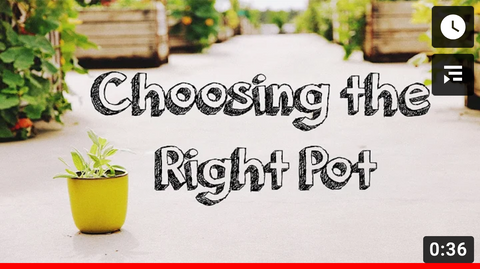Choosing the Right Pot Size

Probably the most under-appreciated part of small-space gardening is choosing the correct-sized pot. A trap that many new gardeners fall into is buying a pot just bing enough to accommodate the seedling they have bought. We don’t like to grow in anything smaller than 30 cm in diameter. After all, a small pot is like the relationship that is destined to fail. It seems like a great match, but there is ultimately no room for growth and it turns out to be a lot of hard work with very little reward. A large pot, on the other hand, is a keeper. Sure, it’s an investment and you will need to make changes in your life to accommodate it, but this is something that will help you grow things that last.
The hardest thing in choosing a huge pot for a small seedling is how ridiculous it looks - worse than when your parent bought you a school uniform three sizes too big. But if you can overcome the laughter and humiliation, larger pots will give the plant more room to grow and let it soar like an eagle. Such a simple way to get the most out of your plants.

Seems like the right fit… a small pot for a small plant.

Plants that grow in small pots quickly become tired and root-bound. Like a teenagers growing foot, those school shoes need some wiggle room if they’re going to last until semester 2. Not only do small pots restrict the true potential of your plant, but they make life real tough because the smaller the vessel the quicker it dries out.

The relationship between plant growth and pot size is this: the larger the pot the more your plant will grow.

Planting a tiny seedlings a huge pot may appear a great waste of resources and a little silly at first…

Hey presto - a rosemary plant for life. Large pots allow your plants to reach their full potential and contribute a truckload more produce to your table.
A good use of pots is a very adaptable and effective way to garden. We have grown everything from mint to fruit trees in pots, which can vary in size from the classic terracotta vessel, to a wine barrel, to a 50-gallon drum. For many city gardeners and renters, this may be the most obvious growing method, if not the only starting point. Pots can complement a larger garden or be the main feature, it just depends on the space.
Types of Pots
Terracotta: Made from moulded, baked clay. Terracotta is porous and prone to drying out. Glazed pots are watertight, but will cost more.
Timber: Timber boxes make beautiful planters, but be sure they are not made from treated wood that could contaminate your food. To avoid this, consider nesting a plastic or polystyrene box within to carry water and soil.
Plastic: Cheapest to buy, but costly to the environment. Be sure that pots are UV stabilised and made from recyclable PE plastic.
Recycled polystyrene: So ugly, but so good for growing plants. Well- insulated and durable, you’ll get about 10,000 years out of one of these. Nest inside a timber box for a combination of function and fashion.
Whether we are filling a new pot, wicking bed, wall garden or raised garden bed, we always add worm castings and rock minerals to help jump-start soil life. If you foster a healthy ecosystem, you will create lasting soil (even in a pot); something that remains fertile and active long into the future. Edible gardening isn't limited to backyards and in-ground gardening; choose the right sized pot and you will get the most out of your plants.
-
Posted in
infrastructure, videos
